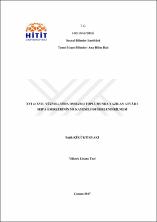XVI ve XVII. yüzyıllarda Osmanlı toplumunda yazılan Atvâr-ı Seb'a eserlerinin mukayeseli değerlendirilmesi
Citation
Küçüktiryaki, F. (2017). XVI ve XVII. yüzyıllarda Osmanlı toplumunda yazılan Atvâr-ı Seb'a eserlerinin mukayeseli değerlendirilmesi (Yüksek Lisans Tezi).Abstract
Mutasavvıflara göre insanın bu âlemdeki fiziki oluşum ve gelişimi doğum ile baş-ladığı gibi insanın manevi seyri de "vilâdet-i sânî/ikinci doğum" denilen doğumla başla-maktadır. Sâlik, bu doğumla sûfî ıstılahında veled-i kalbî (kalp çocuğu) denilen can po-tansiyelinin nüvesini, kendi iç aleminde vücûda getirerek yeni bir varlık ve gerçek "ben"ini keşfe başlamıştır. Bahse konu olan bu açığa çıkarma/keşf ameliyesi insanın özü ve emir âleminden ruhunun, halk âleminden olan beden ve ona ait bağlardan kurtarılarak tekrar aslî vatanına urûc edebilmesi sufilerce Kur'ân ve Hadîs kaynaklı bir takım temrin-lerin yerine getirebilmesine bağlanmıştır. Anadolu'nun İslâmlaşmasıyla, tasavvufî ilimlerin Anadolu'da teşekkülünde bir eş zamanlılık söz konusudur. Zira Anadolu'nun Müslümanlaşmasında, İslâm'ın sevgi me-deniyetinin ve kardeşlik ruhunun teessüsünde, gönüllere hitap eden mutasavvıfların bü-yük rolü olmustur. Çesitli sebeplerle Orta Asya'dan Anadolu'ya gelen dervişler, her git-tikleri yerde faaliyetlerine merkez olmak üzere tekke ve zâviyeler inşa etmişlerdir. Ana-dolu'nun Türk yurdu hâline gelmesi ve Müslümanlaşmasında; siyasî, askerî, iktisadî, bir çok faktörün yanında, Anadolu'da sayısız köy, kasaba ve mahallenin çekirdeğini oluştu-ran tekke, zâviye ve diğer dinî müesseseler, fevkalâde önemli görevler ifa etmiştir. Ana-dolu'nun her tarafında rastlanması mümkün olan bu tekke ve zâviyelerde, fevkalâde çalışkan, yerleştikleri yerlerdeki toprağı işleyen ve İslâm dinini yayan dervişlere, zamanın idarecileri tarafından bir takım muafiyetler de getirilmistir. Anadolu'da İslâm'ın köklü eğitim kurumları olan medreseler bulunmasına rağmen, toplum hayatında tekkelerin rolü ve etkisi, medreselerden çok büyük olmuş ve İslâmiyet, geniş halk yığınlarına tekkeler vasıtasıyla yayılmıştır. Osmanlı toplumunda işte bu tesirin tezahürü olarak zahir ilimlerle mücehhez olan kimi sûfîlerin müderrislik yaptıklarını söyleyebiliriz. Medreselerde talebe okutan bu zâtlar bir taraftan da boş durmayıp İslâmî ilimlerin her sahasında eserler te'lif etmişlerdir. Konumuz olan "Atvâr-ı Seb'a" eserleri de diğer İslâmi ilimlere dair telîf edilen kitapların yanında azımsanmayacak bir konuma sahiptir. Osmanlı Devleti'nin kuruluşunu takip eden yüzyıllarda bu konudaki telif eserler daha fazla olmuştur. Öyleki yurtiçi ve yurt dışındaki kütüphanelerde müellifi belli olan veya olmayan bu eserler hayli yekün tutmak-tadır. Özellikle XVI ve XVII. yüzyıllarda Halvetî Tarîkatına mensûb meşâyihin atvâr-ı seb'a konusunda diğer tarîkatlara nisbetle daha fazla eser telif ettikleri tesbit edilmiştir. Bu gerçekten hareketle tezimizde atvâr eserlerini mukayeseye tabi tuttuğumuz müellifle-rin de genellikle Halvetîye'ye mensup olduklarını söyleyebiliriz. According to the sufis, just how the physical being and development of a hu-man begins with the physical birth, the spritual journey of man is classified as the se-condbirth. The seeker begins exploring the existence of his core. He begins to explore and bring about that which is called "the child of the heart" and begins to explore the ego and a new dimension within himself. This exploration takes place by the spirit esca-ping from its physical connection and ascends to its original homeland. The Sufis claim that this is possible by applying certain practices which are based upon the Qur'an and the Prophetic tradition. The Islamization of Anatolia and the Sufi teachings spreading inside that land had taken place in the same time frame. The Sufis played a great role in the Islamization of Anatolia and the brotherly spirit and love of Islam being formed in-side that region. The dervishes who had migrated from mid Asia to Anatolia for diffe-rent purposes had built Sufi lodges as the centre of their activities wherever they went. Alongside political, military and economical factors, the Sufi lodges which had formed the seeds of many cities and villages, had played a great role in Anatolia embra-cing Islam. The dervishes of these Sufi lodges which can be found everywhere in that region, who were very hard working and were spreading Islam, were given some exemp-tions by the leaders of that time. Although the madrasah's (The schools which the legal rulings of Islam are taught) had existed in the region of Anatolia, the effect of the Sufi lodge played a much greater role than the madrasah in the lifestyle of the community. Islam was spread to large crowds by the means of these Sufi lodges. As a result of this effect, in the Ottoman community the Sufis who were autho-rized in exoteric knowledge had taught in madrasah's. Alongside teaching students in these schools, they had also written works on different branches of Islam. The subject of this thesis "Atwar-i Sab'a" is a piece of work which plays a role that cannot be underes-timated. In the remainig years of the establishment of the Ottoman empire, many more of such works had been written. There is a large amount of such books (Some of them which the authors are known and some of them which are unknown) in the libraries in-side and outside of that region. Especially in the 16th and 17th centuries, the masters of the Halveti Sufi path had written more works in comparison to the other sufi paths on the topic of "Atwar-i Sab'a". Coming from this reality, when we compare the works written on Atwar, we can say that the authors of these works generally belong to the Halveti Sufi practice.


















